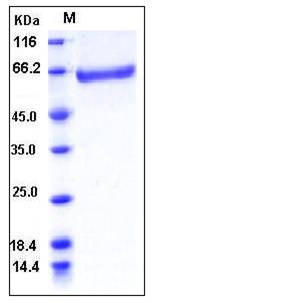Human Coagulation Factor XIII B chain / F13B Protein (His Tag)
FXIIIB
- 100ug (NPP3752) Please inquiry
| Catalog Number | P11510-H08H |
|---|---|
| Organism Species | Human |
| Host | Human Cells |
| Synonyms | FXIIIB |
| Molecular Weight | The secreted recombinant human F13B consists of 652 amino acids and predictes a molecular mass of 74.5 kDa. In SDS-PAGE under non-reduced conditions, the apparent molecular mass of rh F13B is approximately 65 kDa. |
| predicted N | Glu 21 |
| SDS-PAGE |  |
| Purity | > 95 % as determined by SDS-PAGE |
| Protein Construction | A DNA sequence encoding the human F13B (P05160) (Met 1-Thr 661) was expressed, fused with a polyhistidine tag at the C-terminus. |
| Bio-activity | |
| Research Area | Immunology |Innate Immunity |Coagulation |
| Formulation | Lyophilized from sterile PBS, pH 7.4 1. Normally 5 % - 8 % trehalose and mannitol are added as protectants before lyophilization. Specific concentrations are included in the hardcopy of COA. |
| Background | Coagulation factor XIII B chain, also known as Fibrin-stabilizing factor B subunit, Protein-glutamine gamma-glutamyltransferase B chain, Transglutaminase B chain and F13B, is a secreted protein which contains 10 Sushi ( CCP / SCR ) domains. Coagulation factor XIII is the last zymogen to become activated in the blood coagulation cascade. Plasma factor XIII is a heterotetramer composed of 2 A subunits and 2 B subunits. The A subunits have catalytic function, and the B subunits do not have enzymatic activity and may serve as a plasma carrier molecules. Platelet factor XIII is composed of just 2 A subunits, which are identical to those of plasma origin. The B chain of factor XIII is not catalytically active, but is thought to stabilize the A subunits and regulate the rate of transglutaminase formation by thrombin. Factor XIII acts as a transglutaminase to catalyze the formation of gamma-glutamyl-epsilon-lysine crosslinking between fibrin molecules, thus stabilizing the fibrin clot. Factor XIII deficiency is classified into two categories: type I deficiency, characterized by the lack of both the A and B subunits; and type II deficiency, characterized by the lack of the A subunit alone. These defects can result in a lifelong bleeding tendency, defective wound healing, and habitual abortion. Defects in F13B are the cause of factor XIII subunit B deficiency ( FA13BD ) which is an autosomal recessive disorder characterized by a life-long bleeding tendency, impaired wound healing and spontaneous abortion in affected women. |
| Reference |
